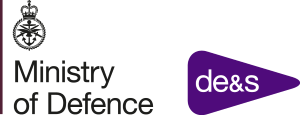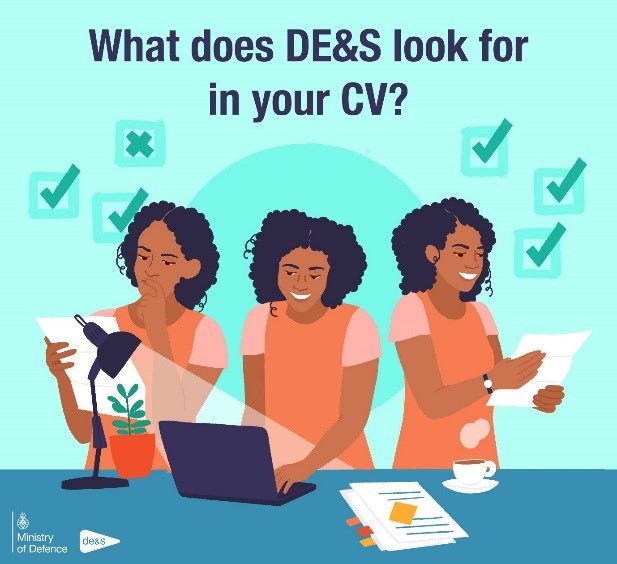How to write a great CV
Category: Tips and Advice
Publish date: 04/10/2021
 What DE&S looks for in a CV
What DE&S looks for in a CV
A high-quality CV is essential for securing an interview. It’s your first opportunity to sell yourself show us that you have the skills and experience that make you the best person for the job. Every job is different and you should tailor your CV for every role you apply for, ensuring that it highlights your relevant (or transferable) skillsets in line with the essential criteria listed in the job advert.
Remember to avoid using acronyms wherever possible; many civilian employees may not be aware what the acronyms mean and could dismiss your CV due to a lack of understanding. Make it as clear and concise as possible, ensuring titles held and acronyms are spelt out.
 Your CV should consist of the following components
Your CV should consist of the following components
Personal profile
This is your introduction to us. You should use this area to give a brief background of yourself. Good practice is to include your current role, at least one professional accomplishment and a summary of your main skills and qualities against the job description.
Key achievements
An achievement should be something that’s quantifiable. Employers love to read through key achievements, but they’re especially interested in the impact and outcome for the organisation and yourself. So, make sure to include this on the Key Achievement section of your CV.
Consider what you’ve accomplished: What situation did you face and what were the tasks? How did you approach it and what actions did you take? What was the result?
This is your opportunity to showcase your successes, how you exceeded targets or went above and beyond what was expected of you. What was challenging and significant? Between three and five examples are best practice.
Relevant experience
List your job/professional experience in reverse chorological order, highlighting to what extent they demonstrate your suitability for the advertised role. Include:
- Job title, employer’s name, and dates of employment
- Your main activities and responsibilities within that role (particularly if it’s relevant to the advertised role)
- The main skills you used, which should be linked and relevant to the job advert
Write small paragraphs for each role and briefly explain any career gaps.
Applied knowledge and skills
This is your opportunity to really promote the skills and knowledge you gained in one role or activity and applied to others you’ve held. If you have any unique skills that’ll help you stand out from other candidates, please include them.
We’d recommend bullet pointing these skills so they’re clear and easy to read; accompanied by a brief explanation about how you acquired this skill and where and how you’ve used it.
Make sure to go through the job description to identify the specific qualities the employer is looking for so you can match them with yours. There needs to be enough information in this section to help us understand if your skills and experience are relevant and transferable to the advertised role.
Qualifications
List your professional memberships and academic qualifications in reverse chronological order (most recent first), ensuring you’ve included those relevant to the job you’re applying for.
In addition to these key elements, your CV should also include the following:
Additional capabilities
Do you have interests that carry responsibility in your personal life that highlight leadership, organisational and communications skills? Any activities or hobbies outside your scope of work? Perhaps you’re a volunteer, school governor, a scout or guide leader?
There are many activities you could list here, and it’s your final opportunity to make a positive impression on us. Always remember that you need to show skills that could be transferable to the role.
What our recruiters say:
Molly Brett Recruiter for Project Controls and Project Management:
“The main points I look for are formatting, clear and easy-to-read information, and being concise and relevant to the post being applied for (as opposed to sending out master CVs for every job role). Talent Acquisition initially sift CVs against the essential criteria, so this needs to be clearly highlighted in your CV. The sifters then score against key achievements, relevant experience, applied skills and knowledge. Comments I regularly get from sifters are that people haven’t applied the ‘so what’ factor or utilised the STARR (Situation, Task, Activity, Result, Reflection) technique format when writing their CVs.”
Daryl Mazelin Recruiter for Corporate Services and Finance & Accounting
“Keep your CV relevant to the advert requirements. I often find large chunks of CVs aren’t relevant to the actual job description, so I’d recommend you read back through your CV and ask yourself, ‘Is this relevant?’. Recruiters don’t have time to read between the lines to find your skillset – highlight your skills and make them easy to identify, avoiding long paragraphs. Recruiters tend to find that the majority of Service leavers rarely mention or highlight their key achievements. Sell yourself and how you meet the key criteria. Spend time on this section to clearly explain your achievements that are relevant to the role. This will increase your chances of making it through the initial sift. Extra-curricular activities – only include additional activities that highlight a relevant skill or talent, for example if they demonstrate strengths in leadership, organisation, or communication.”
The STARR technique
The STARR technique is an excellent tool that helps you present examples as part of your written application or in an interview. It allows you to describe a situation or problem; highlight the task you had to accomplish; explain what actions you took to achieve the task; and show the result – what you achieved and what you learned.
- Situation
- Task
- Action
- Result
- Reflection
Step 1 – Situation
Describe the situation that you were confronted with. With the STARR approach you need to set the context. Highlight if there were any external factors outside your team that affected what you needed to do.
Step 2 – Task
In light of the situation, what was the task you needed to perform? Make it concise and informative, concentrating solely on what is useful and relevant.
Step 3 – Action
This is the most important section of the STARR approach as it’s where you’ll need to demonstrate and highlight the skills and personal attributes that the question is testing. Now that you’ve set the context of your story, you need to explain what you did. In doing so, you’ll need to remember the following:
- Be personal, i.e. talk about you, not the rest of the team.
- Go into some detail. Do not assume that the reader or interviewer will guess what you mean.
- Steer clear of technical information, unless it is crucial to your story.
- Explain what you did, how you did it, and why you did it.
Step 4 – Result
Explain what happened in the end. Use the opportunity to describe what you accomplished and what you learnt in that situation. This helps you make the answer personal and enables you to highlight further skills.
This is probably the most crucial part of your answer. Interviewers want to know that you’re using a variety of skills to achieve your objectives. You must be able to demonstrate that you took certain actions because you were trying to achieve a specific objective, and that it didn’t happen by chance.
Step 5 – Reflection
What did you learn from the task you’ve discussed? Think about the method you used and if there is anything you would change or do differently should the situation arise again.
We have on-going opportunities across a wide range of specialisms, and DE&S are proud to work closely with CTP to support Service leavers through their transition into civilian life. All of our Level 1-5 vacancies are advertised on CTP’s online job portal, RightJob, and regularly attend CTP Virtual Employment events to help Service leavers gain an insight into what it’s like to what for us.